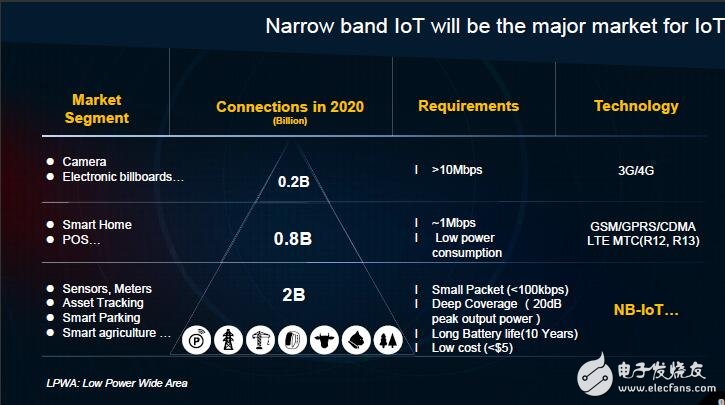origin
Patrick has worked in the wireless field for 16 years. With the maturity of wireless technologies, especially the development of low-power wide-area networks (LPWAN) based on the Internet of Things, there are various media promotions in this market, including exaggerated components. . We have read a lot of articles, let us think that satellites can burn our brains, and some mobile phones may cause brain tumors. Most of the articles stem from limited understanding of technology. At present, the articles on low-power wide-area networks are flooded with various screens, and it is time to explain some common publicity points.
In order to uncover some so-called myths, it is necessary to understand what LPWAN is, and the status of NB-IoT in this ecosystem. It is also necessary to understand the evaluation of various LPWAN technologies.
Clarify some issues
The narrowband Internet of Things (NB-IoT) is an important topic of 3GPP's R13, which was frozen in June 2016. At present, NB-IoT is only a part of R13. It mainly covers three aspects of improvement, which may affect different networks in different countries, and R13 also involves eMTC and EC-GSM-IoT. Many articles describe the NB-IoT often with the title of 3GPP R13, which actually misleads the reader to some extent.

For low-power wide-area network technology, we can explore the licensed spectrum series technology. The licensed spectrum series products are generally called Mobile Internet of Things, and can be divided into four aspects:
(1) "Top number person" is LTECat 1, this term first appeared in 3GPP R8, but it is somewhat far-fetched to call it low power, just like using squid to feed Godzilla, it is impossible to achieve its power consumption. Requirements. Its downlink and uplink rates are 10Mbps and 5Mbps, respectively, and real-time online using Mimo technology.
(2) What follows is LTE Cat 0, which is implemented in 3GPP R12. Relatively speaking, it has some improvements, and its bandwidth has dropped by more than 10 times, but the power consumption has not been greatly improved.
(3) Next is eMTC, or LTE Cat M. This is the first attempt on low-power WAN technology. The researchers have done a lot of work.
(4) Finally, NB-IoT appears. Actually, its official name "LTE Cat NB1" should be used, and its connection rate is 250 kbps. When the 3GPP R13 version is commercially deployed, this will be the most important application direction in its series of technologies.
Six questions about NB-IoT
We are clearly aware of some exaggerated content in news reports. When we see some news about the narrowband IoT trial commercial, we should clearly identify the commercial trials for LTE Cat1, Cat0 or eMTC, and some are not commercial trials of NB-IoT.
At present, the market is indeed full of exaggerated content in NB-IoT and other LPWAN, and some involve different technologies such as LoRa, Sigfox and NB-IoT. It mainly includes the following aspects:
Question 1: NB-IoT will eliminate Sigfox and LoRa
Sorry, no. This reminds me of the legend that the radio eliminates the TV, the FM device replaces the medium wave device, and the wireless phone eliminates the mobile phone. Of course it is impossible. There are reasons behind the development of technology, and we should be convinced. Faced with a vague market space, hundreds of millions of investment and commercial cases can illustrate market choices. All different technological inventions are worthy of respect and can be applied in various cases. NB-IoT will be deployed in large-scale commercial deployments next year or next year. It is ideal for ATMs, EPOS devices, smart healthcare, information gathering, and other devices that require continuous connectivity. Future evolution will include real-time connectivity, low latency, and a significant portion. The device has DC or AC power. Sigfox is an ultra-narrowband architecture and LoRa is an ultra-wideband architecture. (Translator's Note: The original author's discussion is somewhat inappropriate, and it seems that the application scenario and future evolution of NB-IoT are not correct)
Wireless Smartphone Charger,Wireless Charger,Android Wireless Charger,Apple Iphone Wireless Charger
Dongguan baiyou electronic co.,ltd , https://www.dgbaiyou.com